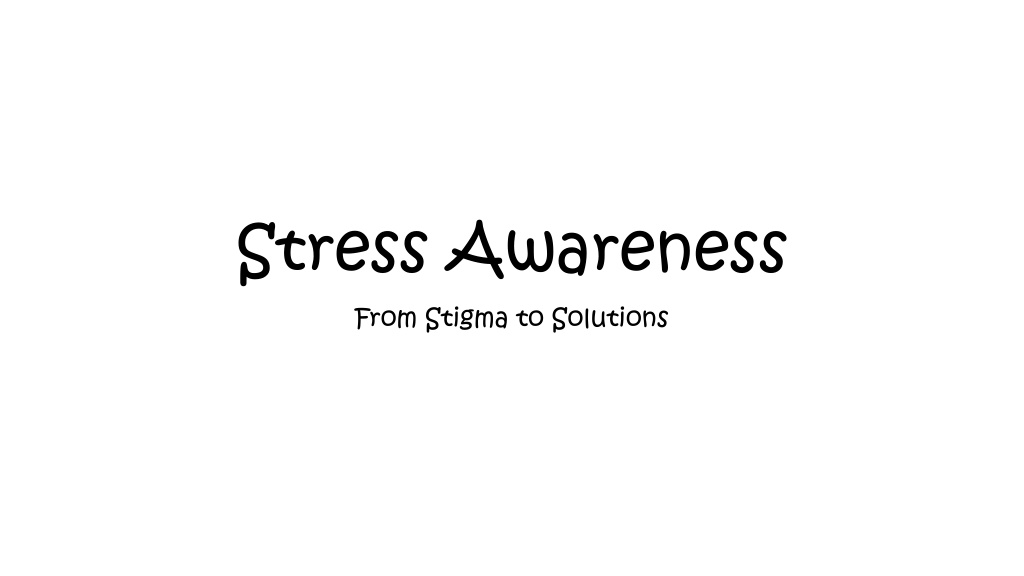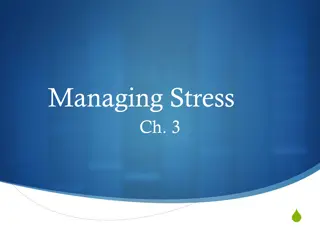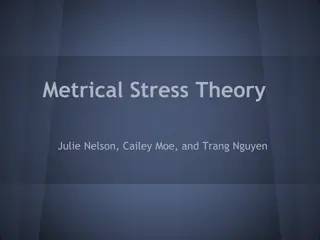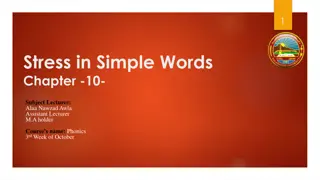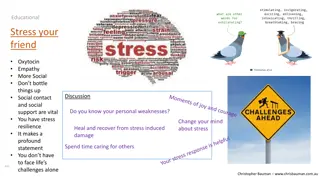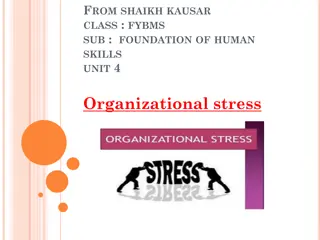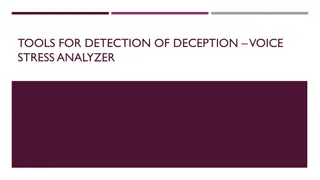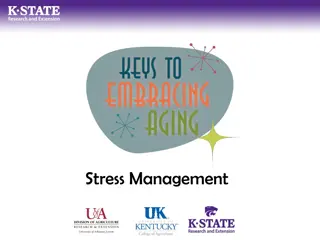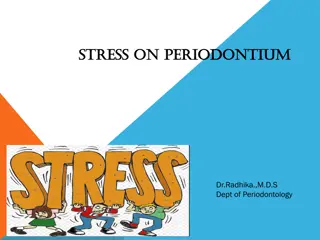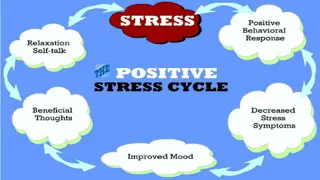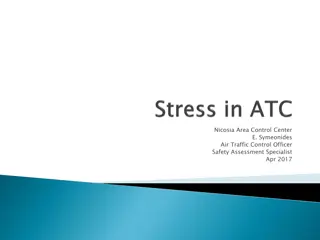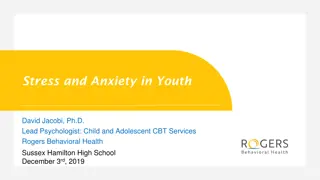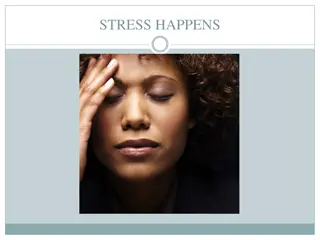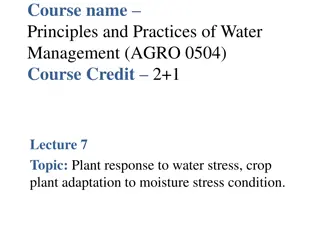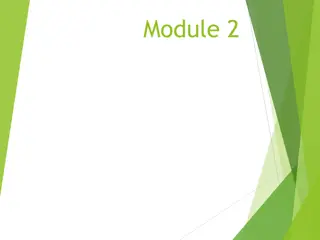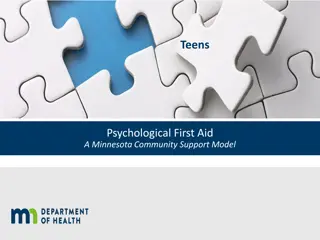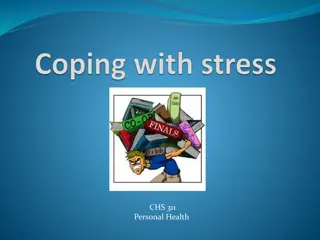Understanding Stress: From Awareness to Management
Stress is a common part of life, but when left unchecked, it can have detrimental effects on physical and mental health. This article explores the symptoms of stress, the difference between acute and chronic stress, and provides insights on stress management strategies to help individuals build resilience and protect their well-being.
Download Presentation

Please find below an Image/Link to download the presentation.
The content on the website is provided AS IS for your information and personal use only. It may not be sold, licensed, or shared on other websites without obtaining consent from the author. Download presentation by click this link. If you encounter any issues during the download, it is possible that the publisher has removed the file from their server.
E N D
Presentation Transcript
Stress Awareness From Stigma to Solutions
Stress management Work, deadlines, bills, homework, chores... and the list goes on. The demands of daily life pull us in all different directions, requiring time and energy that we don t always have. At some point, just maintaining a to-do list becomes a to-do of its own. When these demands grow out of hand, they may lead to the all-too- familiar feeling of stress. Stress is insidious. When stress goes unchecked, its symptoms linger and chip away at both physical and mental health. Many grow used to the constant feeling of stress pressing down on them, while others wear their stress as a badge of honor. That being said, it s okay to have some stress. A healthy level of stress pushes people to take care of their responsibilities, without keeping them up at night or damaging their health. The goal isn t to eliminate all stress it s to keep stress at levels that are helpful, rather than harmful.
What is stress Stress is a feeling of being tense, overwhelmed, worn out, or exhausted. A small amount of stress can be motivating, but too much stress makes even small tasks seem daunting. Symptoms can range from mild (e.g., headaches and stomachaches) to severe (e.g., anxiety and depression). Acute vs. Chronic Stress Acute stress is brief but intense. Short-term stressors such as giving a speech, getting into an argument, or studying for an exam cause acute stress. Chronic stress, on the other hand, is long-lasting. The symptoms may not be as intense in the moment, but the long-term effects are more severe. Long-term stressors such as a difficult job, an unhealthy relationship with frequent arguing, or financial difficulties cause chronic stress. The symptoms of acute stress, such as sweating, irritability, and headaches, are disruptive in the moment. The symptoms of chronic stress might go unnoticed in the moment, but cause serious long-term health problems. Note: Those with chronic stress often become accustomed to the discomfort, and the feeling of stress becomes their new normal . However, the negative health effects persist.
Symptoms of Stress Stress causes physical, emotional, and behavioral symptoms. Some people will have an easy time identifying their symptoms, and connecting them with stress. Others especially those who have had chronic stress for years and years will need more guidance before recognizing their symptoms as stress-related. Acute Symptoms symptoms that occur before or during a stressful situation Physical Emotional/Cognitive Behavioural Asthma Worry Nail biting Headaches Irritability Constant thoughts about stressors Migraines Anger Restlessness Back pain/Chest pain Loss of Motivation Teeth grinding Sweating Difficulty concentrating Disrupted sleep, diet and exercise Nausea Mood Instability Interpersonal conflict Indigestion Decreased sex drive Social withdrawal Fatigue Memory Problems Procrastination Chronic Symptoms symptoms & consequences of long-term stress Physical Emotional/Cognitive Behavioural Heart Disease Depression Sleep disorders Anxiety Disorder Memory impairment Weakened immune system Skin Diseases Substance use Poor diet and exercise habits
Learning Stress Management Strategies What you can do to help yourself: Build Resilience Resilience refers to the ability to handle stress when it arises, and to protect oneself against future stress. Research has shown that there are a number of qualities that contribute to resilience, including social support, optimism, sense of humor, spirituality, self-esteem, and adaptability Positive Journaling Positive journaling can foster optimism, which contributes to stress resilience. Positive journaling involves writing about daily positive experiences. It tends to be easy to remember negative experiences, but it takes more work to recall and appreciate positive experiences. Positive journaling is a great way to appreciate these experiences. Show gratitude Showing gratitude can increase self-esteem, which contributes to resilience. There are a number of ways to show gratitude, including gratitude journaling, telling someone thank you , and visiting someone you appreciate. Practice Relaxation Techniques Relaxation techniques, such as deep breathing and progressive muscle relaxation, are a fundamental part of stress management. These techniques trigger the relaxation response, which counters the body s stress response.
Time Management Too much to do, and too little time. Balancing responsibilities and fitting them into a busy schedule is a common stressor. Time management skills can reduce the mental burden of juggling tasks, and increase the likelihood that everything gets done. Time Management Tips Use a to-do list or appointment book. Writing down your responsibilities has a number of benefits. Not only will it ensure you don t forget anything, it also reduces stress by allowing you to drop your mental to-do list. Prioritize your tasks. Focus on completing the most important, and the quickest tasks, first. If you have a few to-dos that will only take five minutes, knock them out quickly for the peace of mind. Break large tasks into smaller pieces. It s easy to feel overwhelmed when you have a really big task before you. Breaking big tasks into small pieces will help you get started, which is often the hardest part. For example, writing a paper can be reduced to pieces such as doing research, preparing an outline, and writing an introductory paragraph. Limit distractions. Spend a few days recording how much time you spend on distractions such as social media or TV. Then, cut out the distractions you don t actually enjoy, and schedule time for the ones you do enjoy. Always set an alarm so you know when to get back to work. If you can t limit your distractions, get away from them. If you know that you will succumb to distractions, get away from them. Create clear boundaries between work and play by putting up a Do Not Disturb sign on your door, turning off your phone, or going to a coffee shop without a TV. Everyone is different in this regard make the changes you need to focus. Let yourself be less than perfect. If you try to complete every task to perfection, some of your other responsibilities won t get done at all. Focus on completing everything to an acceptable level, and then go back to improve upon your work if you have time.
Self-Care When stress is at its worst, hobbies, relationships, and free time are neglected. As a result, stress worsens. This creates a cycle where self-care is neglected, and stress grows. Self-care refers to your favorite activities that help you relax, have fun, or feel energized. These could include talking with a friend, going for a walk, reading, listening to music, or whatever else you enjoy. The important part of self-care is not so much what you do it s just that you do it. To start, a Self-Care Assessment can be used to explore current self-care habits while giving ideas of where self-care can be improved Self-Care Tips Self-care means taking time to do things you enjoy. Usually, self-care involves everyday activities that you find relaxing, fun, or energizing. These activities could be as simple as reading a book, or as big as taking a vacation. Self-care also means taking care of yourself. This means eating regular meals, getting enough sleep, caring for personal hygiene, and anything else that maintains good health. Make self-care a priority. There will always be other things to do, but don t let these interrupt the time you set aside for self-care. Self-care should be given the same importance as other responsibilities. Set specific self-care goals. It s difficult to follow through with vague goals, such as I will take more time for self-care . Instead, set specific goals, such as I will walk for 30 minutes every evening after dinner . Make self-care a habit. Just like eating one apple doesn t eliminate health problems, using self-care just once won t have much effect on reducing stress. Choose activities that you can do often, and that you will stick with. Set boundaries to protect your self-care. You don t need a major obligation to say no to others your self-care is reason enough. Remind yourself that your needs are as important as anyone else s. A few minutes of self-care is better than no self-care. Set an alarm reminding you to take regular breaks, even if it s just a walk around the block, or an uninterrupted snack. Oftentimes, stepping away will energize you to work more efficiently when you return. Unhealthy activities don t count as self-care. Substance use, over-eating, and other unhealthy behaviours might hide stress temporarily, but they cause more problems in the long run. Keep up with self-care, even when you re feeling good. Doing so will keep you in a healthy routine. Plus, self-care might be part of the reason why you re feeling good!
Cognitive Restructuring Stress is caused by our thoughts about a situation, not by the situation itself. Two people in the exact same situation might have different levels of stress (or no stress at all), just because of how they think about it. Often, the thoughts that cause stress are irrational or exaggerated, but we respond to them as if they are factual. Irrational thoughts that lead to stress may look like the following: I ll never get through this. I have to be perfect all the time. If I don t get an A on the test, I m a total failure. The process of identifying and changing these irrational thoughts is called cognitive restructuring. Cognitive restructuring is the therapeutic process of identifying and challenging negative and irrational thoughts. These sort of thoughts are called cognitive distortions. Although everyone has some cognitive distortions, having too many is closely linked to mental illnesses such as depression and anxiety. Cognitive behavioral therapy (CBT), and several other approaches to psychotherapy, make heavy use of cognitive restructuring. Each of these therapies leverages the powerful link between thoughts, feelings, and behaviours to treat mental illness. The thought-feeling-behaviour link is a big topic in itself, and beyond the scope of this guide. Remember, cognitive restructuring refers to the process of challenging thoughts it isn t a single technique. There are many techniques that fall under the umbrella of cognitive restructuring.
Trust resources You have at your fingertips many resources to help support you if you are feeling stressed or anxious. Check out the Intranet Staff Health and Wellbeing -for resources, ideas and guidance to help you manage your mental health and wellbeing Helplines & Support The Wellbeing Line 9am to 4:30pm, Monday Thursday 9am to 12pm, Friday 0300 421 7500 or visit thewellbeingline.co.uk Working Well is our NHS Occupational Health Service Contact the team on: 01452 894480 workingwell@ghc.nhs.uk or visit workingwellglos.nhs.uk VIVUP Employee Assistance Programme Call 03303 800658 or 0800 023 9324 free from any standard UK landline or mobile phone. Gloucestershire NHS Talking Therapies (formerly Let's Talk) on 0800 073 2200. You can also visit www.letstalkglos.nhs.uk to find out more about the service and the support they can provide
